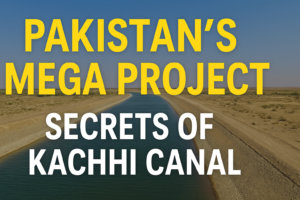A Historical Perspective
The Kachhi region of Balochistan, Pakistan, has been home to ancient civilizations, with Mehrgarh being one of the oldest known settlements in South Asia. This region holds historical significance as early evidence of agriculture and livestock farming from 5500 to 7000 years ago has been discovered here. Despite its rich history, Balochistan remains Pakistan’s largest province by area but has the lowest population density, with around 15 million people as per the 2023 census.
The region’s economy primarily depends on natural resources like gas, coal, and minerals. However, for many, agriculture and fishing are essential for survival. Unfortunately, due to scarce water resources, agricultural development has been a persistent challenge. Climate change and population growth further strain these limited water resources, making irrigation projects like the Kachhi Canal a vital initiative for sustainable development.

The Vision Behind Kachhi Canal
The idea of providing water to Balochistan for agricultural development was initially proposed in the 1970s. In 1991, under a water-sharing accord, Balochistan was allocated 10,000 cusecs of water. To utilize this allocation effectively, the Kachhi Canal project was conceived. This project was designed to bring much-needed irrigation to areas beyond the Nasirabad Division, where the existing Pat Feeder and Kirthar canals had limited reach.
Surprisingly, instead of drawing water from the Guddu Barrage or Kot Mithan, the project was initiated 306 km upstream from the Taunsa Barrage, significantly increasing its length and cost. Had the original plan been followed, the canal would have been only 97 km long, making it cheaper and faster to complete.
Construction and Funding
The foundation stone for the Kachhi Canal was laid on October 4, 2002, by General Pervez Musharraf. Initially, the project was approved at an estimated cost of PKR 3.2 billion, with a completion target of 2007. However, due to delays and cost escalations, revisions were made, and by December 2013, the project’s first phase had its budget revised to PKR 57.6 billion.
In 2017, water flow testing began, and on September 14, 2017, Prime Minister Shahid Khaqan Abbasi inaugurated the canal’s first phase. This phase successfully provided irrigation water to 72,000 acres of barren land in Dera Bugti, Balochistan.
Project Scope and Benefits
The Kachhi Canal spans a total length of 499 km. It originates from the Taunsa Barrage in Punjab’s Muzaffargarh district, passing through Dera Ghazi Khan and Rajanpur before entering Balochistan’s Dera Bugti, Kachhi, and Jhal Magsi districts. The project consists of three phases:
- Phase 1: Covers 363 km and supplies water to 102,000 acres of land.
- Phase 2: A 60 km extension to irrigate 267,000 acres in Nasirabad district.
- Phase 3: A 40 km segment expanding irrigation to 344,000 acres in Kachhi and Jhal Magsi.
Once fully operational, the canal is expected to irrigate 710,000 acres of land, significantly boosting wheat, millet, maize, rice, and oilseed production. Additionally, it will provide drinking water to nearly two million people, transforming livelihoods in this arid region.
Challenges and Future Prospects
Despite its potential, the project has faced numerous delays due to funding shortages and administrative hurdles. The government has allocated additional funds in the 2023-24 Public Sector Development Program (PSDP), and President Asif Ali Zardari has urged the federal government to expedite the remaining phases within the next 18 months.
When completed, the Kachhi Canal will be a testament to Pakistan’s commitment to utilizing its water resources for economic growth. The project aims to convert barren lands into green fields, enhancing food security and contributing to national prosperity. This engineering marvel, built amidst a desert landscape, symbolizes hope for Balochistan’s people, promising a brighter, more sustainable future.
Conclusion
The Kachhi Canal is more than just an irrigation project; it is a lifeline for the people of Balochistan. By harnessing the power of water, this initiative has the potential to turn vast desert expanses into fertile lands, improving livelihoods and strengthening Pakistan’s agricultural economy. As construction progresses, this ambitious project continues to shape the future of Balochistan, paving the way for a more prosperous and sustainable Pakistan.
